Plus One Zoology Chapter Wise Questions and Answers Chapter 8 Excretory Products and their Elimination is part of Kerala Plus One Zoology Chapter Wise Questions and Answers. Here we have given Plus One Zoology Chapter Wise Questions and Answers Chapter 8 Excretory Products and their Elimination.
Kerala Plus One Zoology Chapter Wise Questions and Answers Chapter 8 Excretory Products and their Elimination
Plus One Excretory Products and their Elimination One Mark Questions and Answers
Question 1
Which one of the following is also known as an antidiuretic hormone?
(a) Oxytocin
(b) Vasopressin
(c) Adrenaline
(d) Calcitonin
Answer:
(b) Vasopressin
Question 2.
A large quantity of one of the following is removed from our body by lungs.
(a) CO2 only
(b) H2O only
(c) CO2 and H2O
(d) ammonia
Answer:
(c) CO2 and H2O
Question 3.
The pH of human urine is approximately
(a) 6.5
(b) 7
(c) 6
(d) 7.5
Answer:
(c) 6
Question 4.
Which of the following pairs is wrong?
(a) Uricotelic ________ Birds
(b) Ureotelic _________ Insects
(c) Ammonotelic ________ Tadpole
(d) Ureotelic _________ Elephant
Answer:
(c) Ammonotelic ________ Tadpole
Question 5.
Which one of the following statements is incorrect?
(a) The medullary zone of kidney is divided into a few conical masses called medullary pyramids projecting into the calyces.
(b) Inside the kidney the cortical region extends in between the medullary pyramids as renal pelvis.
(c) Glomerulus along with Bowman’s capsule is called the renal corpuscle.
(d) Renal corpuscle, proximal convoluted tabule (PCT) and distal convoluted tubule (DCT) of the nephron are situated in the cortical region of kidney.
Answer:
(b) Inside the kidney the cortical region extends in between the medullary pyramids as renal pelvis.
Question 6.
Take the odd one justify?
GFR, JGA, ANF, ADH, TSH
Answer:
TSH: all others are the hormones regulate urine formation.
Question 7.
Identify the ammonotelic animal from the following and give reason. (Man, Crow, Lizard, Tadpole)
Answer:
Tadpole
Question 8.
While studying the excretory system in man, a student noticed some words.
RAAS and JGA. Can you help him to expand these terms.
Answer:
RAAS – Renin – Angiotensin – Aldosterone System
JGA – Juxta glomerular apparatus
Question 9.
In ureotelic animals, urea is produced in
(a) Kidney
(b) Liver
(c) Flame cells
(d) Malpighian tubules
Answer;
(b) Liver
Question 10.
State whether true or false and correct the false statements if any:
- Flame cells are the excretory structures in roundworms.
- Fat is absorbed in the form of chylomicrons through the intestinal villi.
- Blood is absent in cockroach.
- Joint between atlas and axis vertebrae is a pivot joint.
Answer:
- False – Flame cells are the excretory structures in flatworms.
- True
- False – Blood is present in cockroach. It is colourless.
- True
Plus One Excretory Products and their Elimination Two Mark Questions and Answers
Question 1.
Draw the schematic diagram of the urine formation. (Hint: Show all the three process involved)
Answer:
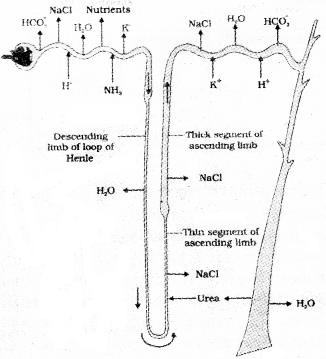
Question 2.
Complete the following sentences.
- Reabsorption of water from DCT is facilitated by the hormone __________
- Kidney failure can cause a bone disorder called _________
- Angiotensin II activates the adrenal cortex to release __________
- In cases of Kidney failure, urea can be removed by the process called __________
Answer:
- ADH
- Gout
- Aldosterone
- Hemodialysis
Question 3.
Pick out the correct word from list provided (Myasthenia gravis, Uremia, Angina, diuresis)
- Autoimmune disorder affecting neuromuscular junction is __________
- Reduce loss of water through urine is _________
- A system of acute chest pain appears when no enough oxygen is reaching the heart muscle is _________
- Accumulation of urea in blood is __________
Answer:
- Myasthenia gravis
- Diuresis
- Angina
- Uremia
Question 4.
Classify the following animals according to their type of excretion.
Frog, Tadpole, birds, man, Turtle, shark, insect, camel
Answer:
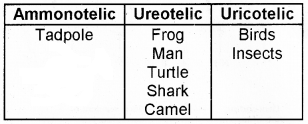
Question 5.
Tadpole is ammonotelic while the frog is ureotelic. Comment on this statement.
Answer:
Tadpole larvae’s habitat is aquatic whereas the frog lives in the terrestrial habitat. So in the aquatic habitat due to the presence of water, ammonia can be excreted easily.
But in frog the water must be conserved. So ammonia is changed into urea which needs only small quantity of water for excretion.
Question 6.
Observe the diagram and answer the following questions.
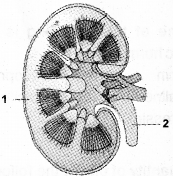
- Label the parts (1) and (2).
- Name the functional unit of the kidney.
Answer:
- The parts are:
- (1) – Renal cortex
- (2) – Ureter
- Nephron
Question 7.
Rearrange the following parts in their correct way.
Glomerulus → Capsular space → loop of Henle → PCT → DCT → Collecting duct → Collecting tubule → Ureter → Renal pelvis → Urethra → Urinary bladder.
Answer:
Glomerulus → Capsular space → PCT → Loop of Henle → DCT →Collecting tubule → Collecting duct → Renal pelvis → Ureter → Urinary bladder → Urethra.
Question 8.
Fill in the gaps:
- Ascending limb of Henle’s loop is ____(1)____ to water. Whereas the descending limb is _____(2)_____ to it.
- Reabsorption of water from distal parts of the tubules is facilitated by hormone __________
- Dialysis fluid contain all the constituents as in plasma except ________
- A healthy adult human excretes (on an average) _______ gm of urea/day.
Answer:
- (1) – Impermeable, (2) -Permeable
- ADH
- Nitrogenous wastes
- 25-30 gm of urea/day
Question 9.
Brain controls the kidney action.
- Name the hormones involved in this.
- How do they act on kidney?
Answer:
- Antidiuretic Hormone (ADH)
- The pituitary gland release the hypothalamic hormone ADH and its is transported to the kidney. The presence of ADH makes the tubules permeable to water. Thus the water is conserved or excreted according to the presence of fluid level in the body.
Question 10.
A patient approaches a doctor having symptoms like excretion of large amount of urine, excessive thirst and dehydration.
- Identify the disease.
- Which hormone deficiency causes this disease?
Answer:
- Diabetes insipidus
- ADH
Question 11.
A table showing the average quantity of urine in a person in two different seasons are given.

- Compare it. Do you agree with this table? State the reason for producing different Quantity in different season.
- Name the hormone responsible for that.
Answer:
- Amount of water in the body is low in summer season and increase its quantity in winter season. In summer season water lose is very high due to various reasons like evaporation. So body eliminate less amount of waterthrough urine to conserve water in the body
- ADH or vasopressin
Question 12.
Teacher asks one of the student to name the excretory organs in man. He names three organs beside kidney. Teacher appreciates him for the correct answer.
- What was his answer?
- Give the excretory role of the above organs
Answer:
- Liver, skin, lungs
- the excretory role of the above organs
- Liver – Excretes cholesterol, bile pigments, etc.
- Skin – Sweat gland- Excretes excess sodium chloride, small amount of urea lactic acid etc. Sebaceous gland excretes lipids such as waxes, steroles, fatty acid etc.
- Lungs – Excretes CO2 and water
Question 13.
Observe the diagram

- Copy the diagram and fill the gaps.
- Write the concentration of glomerular filtrate (Isotonic, Hypotonic, Hypertonic) in the given regions of the nephron.
- Proximal convoluted tubule
- Descending limb
- Ascending limb
- Distal convoluted tubule
Answer:
1.

2. Concentration of glomerular filtrate
- Proximal convoluted tubule – isotonic
- Descending limb – hypertonic
- Ascending limb – hypotonic
- Distal convoluted tubule – Hypertonic
Question 14.
A patient with renal failure in waiting for a kidney donor for a transplantation operation. The urea level is high and the patient is developing symptoms of uremia. What method you can suggest to keep the patient live till a donor can be found. Explain the principle behind it.
Answer:
Haemodialysis. The haemodialyser has a cellophane tube bathed in a fluid with ionic concentration similarto that of plasma. The process of separation of small solutes from macromolecular colloids is done hereby the process of diffusion. So the blood will be free from urea, uric acid and creatinine.
Question 15.
About 125ml of glomerular filtrate is produced per minute in our kidney. However 1ml of urine is produced each minute. What happens to the other 124ml of the filtrate.
Answer:
In man about 125ml of glomerular filtrate is formed per minute. But most of the substances are reabsorbed into tubular network of capillaries. This process is known as selective reabsorption. High threshold substances reabsorbed by active transport and low threshold substances reabsorbed by diffusion.
Question 16.
Consumption of alcohol tends to frequent urination.
- Name the hormone that control it.
- Draw a flow chart showing the action of ethanol present in alcohol and its consequences on urinary system.
Answer:
1. Antidiuretic hormone (ADH)
2.

Question 17.
Prepare a flow chart showing hormonal control by Juxtaglomerular apparatus (JGA) in regulation of kidney function.
Answer:
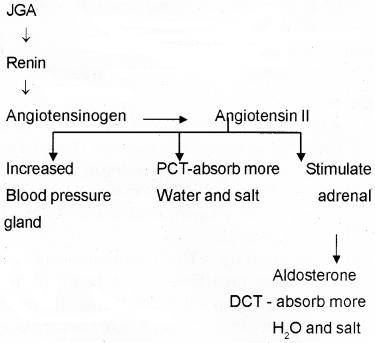
Question 18.
Flow of blood in vasa recta is known as counter-current system. Give reason.
Answer:
The vasa recta is thin walled capillaries lying parallel to the loop of Henle. The blood entering the descending limb of each vasarecta come in close contact with the outgoing blood in ascending limb. This system is called counter current system.
The two limbs of the loop of Henle form another counter current system. These two systems are concentrating the urine in mammalian kidney by diffusion and osmosis.
Question 19.
‘Micturition is an involuntary as well as a voluntary process.’ Justify the statement.
Answer:
The elimination of urine from the urinary bladder is called micturition. The gradual filling of the urinary bladder causes stretching. When the bladder is filled to its limit, the stretch receptors send impulses to the brain to excrete the urine.
The initiation and inhibition of micturition is voluntary in adult but involuntary in children. Due to lack of nervous control the micturition in some humans become involuntary causing bed wetting.
Question 20.
In alcoholic drinkers the urine is dilute. Why?
Answer:
The process of reabsorption of water by the distal parts ofthe kidney tubules become low efficient. This occurs due to the deficiency of ADH. lt leads to diabetes insipedus.
Question 21.
Distinguish between diabetis mellitus and diabetis insipedus.
Answer:
Insulin deficiency causes large amounts of blood sugar to be lost in the urine. It leads to diabetis melitus while the deficiency of ADH leads to diabetes insipedus i.e dilute urine disease.
Question 22.
The failure of removing toxic substances from the blood ultimately leads kidney failure.
- How is it temporarily solved.
- Name the machine is used.
Answer:
- Hemodialysis is an artificial process of removing toxic substances from the blood
- Artificial kidney or Hemodialysis machine.
Plus One Excretory Products and their Elimination Three Mark Questions and Answers
Question 1.
State the differences between the following.
- Tubular reabsorption and Tubular secretion.
- ADH and RAAS.
Answer:
1. Tubular reabsorption:
The process of selective reabsorption of most of the useful substances from the glomerular filtrate in the renal tubule.
Tubular secretion:
It is the process of active secretion of certain substances such as Hydrogen ions, ammonia etc. from the blood into the lumen of the urinary tubules by the tubular epithelium during urine formation.
2. ADH:
ADH is the hormone from posterior pituitary gland, makes the wall of the distal convoluted tube and collecting tubule permeable to water so that more water is reabsorbed.
RAAS:
The Renin-Angiotensin-Aldosterone system increases the blood pressure by constricting arterioles and increases the blood volume by stimulating proximal convoluted tubule.
Question 2.

- What does the diagram represent?
- Name the parts A, B, C, D.
- What is the physiological function taking place in part ‘B.
Answer:
- Nephron
- The parts are
- A – Bowman’s capsule
- B – Henle’s loop
- C – Proximal convoluted tubule
- D – Collecting duct
3. Henle’s loop is the site of osmoregulation in human kidney. The descending limb of loop of Henle is permeable to water but almost impermeable to electrolytes. The ascending limb is impermeable to water but allows transport of electrolyte actively or passively.
Therefore, as the concentrated filtrate pass upward, it gets diluted due to the passage of electrolytes to the medullary fluid.
Question 3.
Observe the diagram and answer the questions.

- Identify the labelled parts A, B, C, D.
- What does the diagram represents?
Answer:
- The labelled parts are
- A – Afferent arteriole
- B – Efferent arteriole
- C – Glomerulus
- D – Bowman’s capsule
- Glomerular Filtration
Question 4.
Observe the diagram given below which represents the counter-current system in nephron and vasa recta. This mechanism helps in maintaining the concentration gradient in the medullary interstitium. Substantiate.
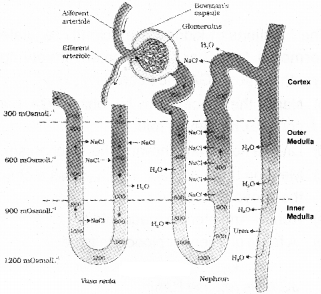
Answer:
The flow of Glomerular filtrate in the two limbs of Henle’s loop is in opposite directions and thus forms a counter current. The flow of blood through the two limbs of vasa recta is also in a counter current pattern.
The proximity between the Henle’s loop and vasa recta, as well as the counter current in them help in maintaining an increasing osmolarity towards the inner medullary interstitium i.e, from 300 mOsmolL1 in the cortex to about 1200 mOsmolL1 in the inner medulla.
This gradient is mainly caused by NACI and urea. NaCl is transported by the ascending limb of Henle’s loop which is exchanged with the descending limb of vasa recta.
Similarly, small amounts of urea enter the thin segment of the ascending limb of Henle’s loop which in transported back to the interstitium by the collecting tubule. This counter-current mechanism helps to maintain a concentration gradient in the medullary interstitium.
Question 5.
The steps involved in the treatment of a uremic patient is given below.
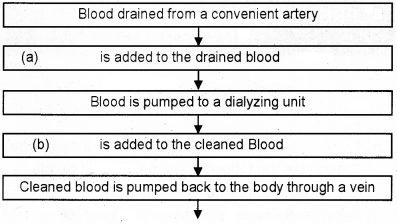
- Complete the missing steps (a) and (b)
- Diagonise the treatment
- Name the organ which is under failure
Answer:
- The missing steps are
- (a) – Anticoagulant like heparin
- (b) – Anti – heparin
- Hemodialysis
- Kidney
Question 6.
- Name the mechanism by which JGA plays a complex regulatory role.
- Draw a flow chart showing the mechanism.
- Mention the feed back which act as a check on the above mechanism,
Answer:
1. Renin-Angiotensin mechanism
2.

3. An increase in blood flow to the atria of the heart can cause the release of Atrial Natriuretic factor (ANF). ANF can cause vasodilation and thereby decrease the blood pressure. ANF mechanism act as a check on the renin-Angiotensin mechanism.
Question 7.
Note the relationship between the first two words and suggest a suitable word in the missing place.
- Cockroach – Malpighian Tubule : Flatworm – _________
- Man – Kidney : Earthworm – _________
- Prawn – Greengland : Amphioxus – __________
Answer:
- Flame cells
- Nephridia
- Protonephridia
Plus One Excretory Products and their Elimination NCERT Questions and Answers
Question 1.
Define Glomerular Filtration Rate(GFR)
Answer:
Glomerular Filtration Rate (GFR). The amount of filtrate formed by the kidneys per minute is called glomerular filtration rate (GFR). GFR in a healthy individual is approximately 125ml/minute, i.e., 180 litres per day. On average, 1100 -1200 ml of blood pumped out by each ventricle of the heart in a minute.
Question 2.
Explain the autoregulatory mechanism of GFR.
Answer:
Regulation of GFR. The kidney have built-in mechanisms for the regulation of glomerular filtration rate. One such efficient mechanism is carried out by juxtaglomerular apparatus(JGA).
JGA is a special sensitive region formed by cellular modifications in the distal convoluted tubule and the afferent arteriole at the location of their contact. A fall in GFR can activate the JG cells to release renin which can stimulate the glomercular blood flow and thereby the GFR back to normal.
Question 3.
Indicate whether the following statements are true or false:
- Micturition is carried out by a reflex
- ADH helps in water elimination, making the urine hypotonic.
- The protein-free fluid is filtered from blood plasma into the Bowman’s capsule.
- Henle’s loop plays an important role in concentrating the urine.
- Glucose is actively reabsorbed in the proximal convoluted tubule.
Answer:
- True
- False
- True
- True
- True
Question 4.
Give a brief account of the counter mechanism.
Answer:
Countercurrent Mechanism. The Henle’s loop and vasa recta play a significant role in this. The flow of filtrate in the two limbs of Henle’s loop is in opposite directions and thus forms a countercurrent.
The flow of blood through the two limbs of vasa recta is also in a countercurrent pattern. The proximity between the Henle’s loop and vasa recta, as well as the counter-current in them, help in maintaining an increasing osmolarity towards the inner medullary interstitium, i.e., from 300 mOsmolL-1 in the cortex to about 1200 mOsmolL-1 in the inner medulla.
This gradient is mainly caused by NaCI and urea. NaCI is transported by the ascending limb of Henle’s loop which is exchanged with the descending limb of vasa recta. NaCI is returned to the intestitium by the ascending portion of vasa recta.
Question 5.
What is meant by the term osmoregulation?
Answer:
Osmoregulation is the regulation of blood volume, body fluid volume and ionic concentration
Question 6.
Match the items of Column I with those of Column II.
Column I Column II
| Column I | Column II |
| (a) Ammonotelism | (i) Birds |
| (b) Bowman’s capsule | (ii) Water reabsorption |
| (c) Micturition | (iii) Bony fish |
| (d) Uricotelism | (iv) Urinary bladder |
| (e) ADH | (v) Renal tubule |
Answer:
(a) – (iii)
(b) – (v)
(c) – (iv)
(d) – (i)
(e) – (ii)
Question 7.
Name the following.
- A chordate animal having flame cells as excretory structures.
- Cortical portions projecting between the medullary pyramids in the human kidney.
- A loop of capillary running parallel to the Henle’s loop.
Answer:
- Cephalochordata
- Columns of Bertini
- Vasa Recta
Question 8.
Fill in the gaps:
- Ascending limb of Henle’s loop is ________ to water whereas the descending limb is __________ to it.
- Reabsorption of water from distal parts of the tubules is facilitated by hormone ___________
- Dialysis fluid contain all the constituents as in plasma except ___________
- A healthy adult human excretes (on an average) _________gm of urea/day.
Answer:
- impermeable, permeable
- ADH
- nitrogenous waste
- 25 to 30
Plus One Excretory Products and their Elimination Multiple Choice Questions and Answers
Question 1.
What will happen if the stretch receptors of the urinary bladder wall are totally removed’?
(a) Urine will not collect in the bladder
(b) Micturition will continue
(c) Urine will continue to collect normally in the bladder
(d) There will be no micturition
Answer:
(c) Urine will continue to collect normally in the bladder
Question 2.
Green glands present in some arthropods help in
(a) respiration
(b) excretion
(c) digestion
(d) reproduction
Answer:
(b) excretion
Question 3.
Excretory product of spider is
(a) uric acid
(b) ammonia
(c) guanine
(d) None of these
Answer:
(c) guanine
Question 4.
Which one is the component of ornithine cycle
(a) Ornithine, citrulline and fumaric acid
(b) Ornithine, citrulline and arginine
(c) Ornithine, citrulline and alanine
(d) Amino acids are not used
Answer:
(b) Ornithine, citrulline and arginine
Question 5.
Urea synthesis occurs in
(a) kidney
(b) liver
(c) brain
(d) muscles
Answer:
(b) liver
Question 6.
Renin is secreted from
(a) juxtaglomerular cells
(b) podocytes
(c) nephridia
(d) stomach
Answer:
(a) juxtaglomerular cells
Question 7.
Loop of Henle is associated with
(a) excretory system
(b) respiratory system
(c) reproductive system
(d) digestive system
Answer:
(a) excretory system
Question 8.
If one litre of water is introduced in human blood, then
(a) BMR increases
(b) RBC collapses and urine production increases
(c) RBC collapses and urine production decreases
(d) BMR decreases
Answer:
(b) RBC collapses and urine production increases
Question 9.
The urine is
(a) hypotonic to blood and isotonic in medullary fluid
(b) hypotonic to bloodand isotonic to medullary fluid
(c) isotonic to blood and hypotonic to medullary fluid
(d) hypertonic to blood and isotonic to medullary fluid
Answer:
(d) hypertonic to blood and isotonic to medullary fluid
Question 10.
Which substance is in higher concentration in blood than in glomerular filtrate’?
(a) Water
(b) Glucose
(c) Urea
(d) Plasma proteins
Answer:
(d) Plasma proteins
Question 11.
A large quantity of fluid is filtered everyday by the nephrons in the kidneys. Only about 1% of it is excreted as urine. The remaining 99% of the filtrate
(a) gets connected in the renal pelvis
(b) is lost as sweat
(c) is stored in the urinary bladder
(d) is reabsorbed into the blood
Answer:
(d) is reabsorbed into the blood
Question 12.
The characteristic that is shared by urea, uric acid and ammonia is/are
I. They are nitrogenous wastes.
II. They all need very large amount of water for excretion.
III. They are all equally toxic.
IV. They are produced in the kidneys.
(a) I and III
(b) I and IV
(c) I, III and IV
(d) I only
Answer:
(d) I only
Question 13.
Does a bird excrete nitrogenous waste materials in the form of?
(a) uric acid
(b) ammonia
(c) urea
(d) amino acids
Answer:
(a) uric acid
Question 14.
Which of the following is correct with reference to hemodialysis?
(a) Absorbs and resends excess of ions
(b) The dialysis unit has a coiled cellophane tube
(c) Blood is pumped back through a suitable artery after hemodialysis
(d) Anti-heparin is added prior to hemodialysis
Answer:
(b) The dialysis unit has a coiled cellophane tube
Question 15.
Find the incorrect statement regarding the mechanism of urine formation in man.
(a) the glomerular filtration rate is about 125 mL/min
(b) the ultrafiltration is opposed by the colloidal osmotic pressure of plasma
(c) tubular secretion takes place in the PCT
(d) aldosterone induces greater reabsorption of sodium
Answer:
(c) tubular secretion takes place in the PCT
Question 16.
The excretory material of bony fish is
(a) urea
(b) protein
(c) ammonia
(d) amino acid
Answer:
(c) ammonia
Question 17.
The yellow colour of urine is due to the presence of
(a) urea
(b) uric acid
(c) urochrome
(d) bilirubin
Answer:
(c) urochrome
Question 18.
Malpighian tubules are
(a) excretory organs of insects
(b) excretory organs of frog
(c) respiratory organs of insects
(d) endocrine glands of insects
Answer:
(a) excretory organs of insects
Question 19.
The size of filtration slits of the glomerulus
(a) 10wn
(b) 15nm
(c) 20nm
(d) 25nm
Answer:
(d) 25nm
Question 20.
The conversion of dangerous nitrogenous waste into less toxic excretory matter is carried out in man in the
(a) blood
(b) liver
(c) kidney
(d) skin
Answer:
(b) liver
We hope the Kerala Plus One Zoology Chapter Wise Questions and Answers Chapter 8 Excretory Products and their Elimination help you. If you have any query regarding Kerala Plus One Zoology Chapter Wise Questions and Answers Chapter 8 Excretory Products and their Elimination, drop a comment below and we will get back to you at the earliest.
